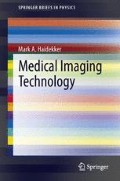Abstract
“Medical imaging refers to several different technologies that are used to view the human body in order to diagnose, monitor, or treat medical conditions”. All imaging modalities have in common that the medical condition becomes visible by some form of contrast, meaning that the feature of interest (such as a tumor) can be recognized in the image and examined by a trained radiologist. The image can be seen as a model of the imaged tissue. Images in the context of this book are digital. This implies a finite resolution with the pixel as the smallest element. Furthermore, all imaging modalities lead to some degradation of the image when compared to the original object. Primarily, the degradation consists of blur (loss of detail) and noise (unwanted contrast). Some underlying principles are common to all imaging modalities, such as the interpretation as a system and its mathematical treatment. The image itself can be seen as a multidimensional signal. In many cases, the steps in image formation can be seen as linear systems, which allow simplified mathematical treatment.
Access this chapter
Tax calculation will be finalised at checkout
Purchases are for personal use only
Notes
- 1.
Examining negative frequencies is not unreasonable. Equation 1.9 holds for \(\omega <0\), and the Fourier transform shows some symmetry. The Fourier transform has a number of very interesting properties, but they go beyond the scope of this book.
Author information
Authors and Affiliations
Corresponding author
Rights and permissions
Copyright information
© 2013 The Author(s)
About this chapter
Cite this chapter
Haidekker, M.A. (2013). Introduction. In: Medical Imaging Technology. SpringerBriefs in Physics. Springer, New York, NY. https://doi.org/10.1007/978-1-4614-7073-1_1
Download citation
DOI: https://doi.org/10.1007/978-1-4614-7073-1_1
Published:
Publisher Name: Springer, New York, NY
Print ISBN: 978-1-4614-7072-4
Online ISBN: 978-1-4614-7073-1
eBook Packages: Physics and AstronomyPhysics and Astronomy (R0)

